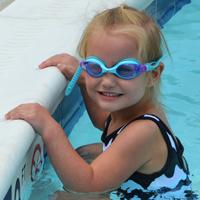Life-Saving Tales and Tips about Water Safety from a 12-year-old Babysitter

by Kaitlyn Recchiuti
Last year, I was at a neighbor’s pool when my mom’s friend took her child’s floaties off. She had placed the child on a pool noodle and then resumed her conversation. The mom was distracted by her friend, so she did not notice the child slowly slipping off the pool noodle. When I looked up, the child’s head was fully submerged in the water. I screamed to the parents, “THE BABY IS UNDERWATER!” The mom swiftly pulled her child’s head above water and the child was fine. But I still remember thinking that the child could have died, a few minutes more without anyone noticing and the child would not be here today.
Unfortunately, not all these situations have a happy ending. Tragically, around 453 children under the age of 5 drown in the U.S. each year. My example is a living and breathing alarm about the need for taking appropriate safety precautions and why this issue is so important to me. I’m only 12 years old but I’ve spent many of those years as an older sister and a babysitter and I have learned many real-life lessons about the need for safety around water. Drownings happen fast and they happen when you least expect them. That is why whether you are a babysitter, older sibling, parent, or caregiver watching kids around water, we all must take key steps to protect young children.
Drowning is one of the leading causes of injury-related deaths seen in children aged 1-4. These deaths can be prevented. I learned that we all must be fully focused on a child’s safety when around pools or open bodies of water. And there are other things we can do as well, like sign your child up for swim lessons. Pools are tons of fun, but there are also risks that can lead to terrible tragedies. The good news is these tragedies can be prevented.
And it’s not just swimming pools. Open bodies of water such as oceans and lakes have added risks as well. Even at my age, I have already been caught in two rip currents. Though I had been taught how to escape the rip current, I just did not put two and two together when it happened. I was caught up in the moment and it was scary. Now before I go swimming, I always remind myself of these four things about rip currents. First, never try to swim directly towards the shore, instead swim parallel to the shore. Once you have escaped the current, you can turn to swim towards the shore. Second, try to stay as calm as possible, you think quicker and have more energy when you are calm. Next, only swim in designated swimming areas and at beaches with lifeguards to ensure your safety. Lastly, never swim alone because if something does go wrong your friends can get the attention of lifeguards.
I’ve also learned that while big bodies of water are clear risks, little kids can drown in waters as shallow as 1 inch. So, it is not just important to watch young kids in pools or the ocean, but also take baths into consideration. When I babysit, I know that while a child is in the bath I cannot take my eyes off them. They can drown as easily as they can anywhere else.
